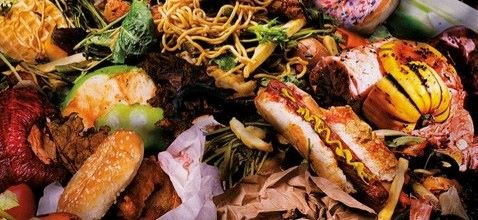
U of M animal science experts build collaborative networks, take multiple paths to find solutions for achieving One Health
Finding solutions to complex global sustainability and One Health challenges requires interdisciplinary teams using holistic approaches to tackle food waste and advance biosafety and biosecurity in animal feeds

The old adage, “waste not want not,” was purportedly first coined in 1772, with its predecessor, “willful waste makes woeful want” dating back to 1576. While we may never know just who coined those sage phrases centuries ago, one thing is certain — the words still ring true today. Just ask the University of Minnesota scientific duo of Gerald Shurson, PhD, and Pedro Urriola, PhD.
The two animal science researchers, with many other U of M experts, have been focusing on the concept of “One Health” (the interconnections of health among people, animals, plants, and their shared environment) as it relates to three distinct but intertwined areas that involve improving the environmental sustainability and biosecurity of animal feed, and using precision nutrition and natural functional properties of some feed ingredients to combat antimicrobial resistance.
The connection between what animals are eating, what landfills are collecting, and what viruses are infecting may not be obvious to the casual observer. But, if you travel back a few years with Shruson, Urriola, and colleagues Sagar Goyal, PhD in the College of Veterinary Medicine (CVM) and Fernando Sampedro, PhD in CVM and the School of Public Health, to the breakout of the Porcine Epidemic Diarrhea Virus (PEDv) in North America in 2013-2014, you can see how the pieces begin to fit together.
Feed ingredients under attack
A variety of ingredients go into feed to ensure the health, well-being and productivity of an animal. Spray-dried porcine plasma (essentially pig’s blood with the cells removed), is a feed ingredient with highly digestible proteins and amino acids, and other health-promoting components.
When PEDv came on the scene in the U.S., causing severe diarrhea and vomiting in swine and killing millions of young pigs, spray-dried porcine plasma was the first feed ingredient to come under fire as the potential cause of infection, with many pork producers and veterinarians questioning its safety.
Because porcine plasma provides important health and nutritional benefits for newly weaned pigs at a critical time in their development, the U of M team wanted to find out how much of a danger it really posed. They conducted several research studies to evaluate the survival of porcine coronaviruses, including PEDv, in various feed ingredients, in thermally-treated feed ingredients, and on surfaces, and the effectiveness of using feed additives to inactivate PEDv in feed. These were all pivotal studies shared with and used by the National Pork Board and the global feed industry.
Fast forward to 2018, when African Swine Fever Virus (ASFV) hit the major global swine producer, China. That year, the world lost 25 percent of the pigs that provide meat protein for human consumption and valuable rendered byproducts for use in animal feed. Instead of entering the food and feed supply, the swine went to landfills, both wasting food and creating environmental hazards.
The ASFV outbreak caused significant confusion and concern around the safety of imported feed ingredients, such as soybean meal and vitamins, coming into the U.S. from ASFV-positive countries. Shurson, a professor in the Department of Animal Science at the U of M’s College of Food, Agricultural and Natural Resource Sciences (CFANS) and expert on swine nutrition, recalls misunderstanding, panic and finger-pointing within the feed and pork industries and the veterinary community about the risk of ASFV contamination in imported feed ingredients.
According to the U.S. Department of Agriculture Animal and Plant Health Inspection Service, ASFV “is a devastating, deadly disease that would have a significant impact on U.S. livestock producers, their communities and the economy if it were found here. There is no treatment or vaccine available for this disease. The only way to stop this disease is to depopulate all affected or exposed swine herds.”
“Based on the devastating effects of ASFV on the global pork supply and previous experiences with PEDv contamination in feed being associated with causing the PEDv outbreak in the U.S., it was no surprise that imported feed ingredients from ASFV-positive countries, like China, needed to be considered as possible entryway into the U.S.,” Shurson said.
In 2019, Shurson and his Department of Animal Science colleague Urriola, a research associate professor and also an expert on swine nutrition, organized supply chain workshops with the vitamin and soybean sectors to bring all of the major stakeholders together.
Following the workshops, a United Soybean Board grant enabled Shurson and Urriola to partner with Declan Schroeder, PhD, associate professor in the Department of Veterinary Population Medicine (VPM); Jennifer van de Ligt, PhD, associate professor in VPM, Director of the Food Protection and Defense Institute, and Director of the Integrated Food Systems Leadership Program; and Cecilia Balestreri, PhD and postdoctoral researcher, to develop a surrogate assay for ASFV based on the virus. The team made a significant discovery.
Called Emiliania huxleyi virus, the surrogate is naturally occurring in the marine environment and only affects algae (not animals, plants, or people), so it is a very safe stand-in for ASFV, while also being remarkably similar in its structure and resilience. “It is an excellent candidate to conduct real-world kinds of experiments in a safe yet replicable way to understand how the ASFV virus behaves, without the risk of transmission or biosafety concerns,” said Shurson.
Addressing ASFV today
ASFV continues to be a major problem. To date in 2021, a second wave of the virus is estimated to have killed more than eight million pigs in China, thwarting the country’s plans to renew its herd. And, for the first time in 40 years, an ASFV outbreak has been confirmed in the Dominican Republic and Haiti, coming closer to North America than ever before.
In an August 2021 interview with Sarah Muirhead of Feedstuffs 365, Shurson shared new perspectives for evaluating the risks of ASFV in global feed ingredient supply chains. In November 2021, he spoke again with Muirhead in an interview titled “Risk assessment of ASFV being introduced into the U.S. via imported ingredients.”
Through global trade, products like grains, oilseeds, vitamins and feed additives enter the U.S. from many different countries. Shurson explains that because we have very little data related to the contamination of the ingredients we import, there is a high level of uncertainty, which makes it difficult to understand and quantify in a meaningful way.
“Many of us who have dealt with biosecurity for a number of years recognize that birds, rodents, domestic pigs, wild boar, or even grain that is drying out on pavements, as is done in some countries, can all serve as risk factors,” he said. “But, just because something is a hazard doesn’t mean it is necessarily a risk.”
Characterizing hazards versus risks
Shurson and Urriola often use a shark analogy to differentiate between a hazard and a risk. An important piece of the work, said Urriola, is understanding that the survival of the virus in the feed ingredient group represents something dangerous, but it does not represent a quantification of the actual risk.
However, Urriola explains that with the food safety expertise of Sampedro; Andres Perez, PhD, professor in the VPM, Endowed Chair of Global Animal Health and Food Safety, and Director of the Center for Animal Health and Food Safety; and others, they are looking at how these pathogens survive and what it takes to inactivate them, using mathematical models to calculate how much inactivation occurs as the feed ingredient is processed.
“By incorporating their food safety and risk analysis experience, the team can more clearly define the probability of ASFV contamination in animal feed actually happening,” said Urriola.
A recent paper — authored by Shurson, Urriola, van de Ligt, Sampedro, Perez, and Rachel Schambow — titled “Rethinking the uncertainty of African swine fever virus contamination in feed ingredients and risk of introduction into the United States,” presents a model that can be used to evaluate risk mitigation strategies and critical control points for inactivating ASFV in feed.
Waste newly placed
Food waste also has a major role to play in the multi-faceted world of animal feed, which Shurson outlines in his recent publication, “What a Waste — Can We Improve Sustainability of Food Animal Production Systems by Recycling Food Waste Streams into Animal Feed in an Era of Health, Climate, and Economic Crises?”
Shurson and Urriola first became involved with the concept of recycling nutrients in food waste into animal feeds in the early days of MNDrive Global Food Ventures in 2014 by collaborating with Larry Baker, PhD, now retired from the Department of Bioproducts and Biosystems Engineering (BBE), and Jennifer Schmitt, PhD, Institute on the Environment. They collaborated on a project called “Waste Not: Closing the Loop on Organic Wastes.”
This led to Shurson and Urriola collaborating with local entrepreneur David Russick to obtain a USDA SBIR (Small Business Innovation Research) grant to conduct nutritional studies (Sept. 2018 and April 2019) to determine the suitability of feeding various sources of thermally-processed food waste to pigs.
“We obtained great results showing that the feeding value of several food waste sources is equal to, or exceeds, traditional ingredients like corn and soybean meal for pigs, which could repurpose food waste from being an enormous environmental burden into a valuable resource in pig diets,” said Shurson.
In the U.S. alone, we discard nearly 80 billion pounds of food yearly; food waste is the largest category of municipal solid wastes in the country. It takes up significant landfill space and is a major contributor to the greenhouse gas emissions from our food system.
In the paper — “Can we effectively manage parasites, prions, and pathogens in the global feed industry to achieve One Health?” — Shurson, van de Ligt, and Urriola briefly review the historical evolution of the feed industry, which was to redirect, recover, and “upcycle” valuable nutrients from byproducts produced by the grain milling, meat packing and milk processing industries in animal feeds to adhere to laws prohibiting these waste streams from being discarded into water sources and causing environmental pollution.
The concept of upcycling nutrients from agro-industrial byproducts is a major focus of Shurson’s and Urriola’s collaborations with Bo Hu, PhD, professor in BBE, who is the principal investigator on a National Science Foundation project focused on developing solid state fermentation of selected fungal species to improve the nutritional value of high fiber byproducts for pigs* (see list of publications). This work has received national and international attention, and this team is collaborating with researchers in the Norwegian Life Sciences University (NMBU) to apply this approach to rapeseed meal.
For the pork industry, ASFV is not the only cause of an enormous number of pigs not entering the food chain. Early in the COVID-19 pandemic, the closure of U.S. slaughterhouses caused major supply chain disruptions, with about three million pigs not entering the food chain. In China, the estimate is 700 million pigs.
That impacts both global food security and the environment, said Shurson. “When you invest so many resources, including energy (carbon), protein (nitrogen), phosphorus, and water into producing a pig that’s at market weight, and it doesn’t go for human consumption, that’s a tremendous loss of not only income and revenue for farmers, but also valuable nutrients that could have been consumed by hungry people,” he said.
Add this to the fact that due to harvest losses, 40 percent of all food produced is not consumed, including 1.2 billion tons of crops that are lost without ever leaving the farm.
“If we’re going to feed a growing population of people, we must first do a better job at preventing food waste and ultimately the food waste that can’t be prevented must be recycled to the highest possible value, which is feeding it to animals,” said Shurson. “There is a lot of dialogue around how we create a more resilient, efficient, less wasteful kind of food system.” Shurson shares details in another conversation with Feedstuffs 365, titled “What a Waste?!”
Always exploring new collaborations and ways to have an impact on our local, regional, national, and international food system, Shurson, Urriola and Hu have been working with Zhengxia Dou, PhD, professor of agricultural systems at the University of Pennsylvania’s School of Veterinary Medicine, on research proposals and educational programs to enhance efforts to more effectively deal with the enormous challenge of food waste in the U.S. Shurson and Dou recently collaborated on a publication for the Council for Agriculture Science and Technology by providing national recommendations for President Biden’s Role of Agricultural Science and Technology in Climate 21 Project Implementation.
Solutions through collaborative science
Shurson emphasizes that meaningful contributions and impact for improving the sustainability and resiliency of our food system depends on interdisciplinary collaboration.
“We must think about these topics from a systems perspective,” he said. “Social scientists, veterinarians, animal production people, practitioners in the food supply chain, distributors — everybody needs to be part of this conversation. It’s complicated and we can’t solve it until we start talking about it and sharing perspectives. All of us involved in research and education related to our food system, including environmental, animal, and human health, have a responsibility to be actively engaged in providing leadership, facilitating dialogue among our stakeholders, and exploring solutions to complex problems. This must be done using ‘team science.’”
So while the old maxim “waste not want not” still applies in these scientific endeavors, perhaps a phrase that arose a few centuries later is more accurate: “Teamwork makes the dream work.”
*Enhanced protein and amino acids of corn–ethanol co‑product by Mucor indicus and Rhizopus oryzae
Impact Winter 2022: Table of Contents
A shortened version of this article was featured in Impact, a quarterly print publication from CFANS.










